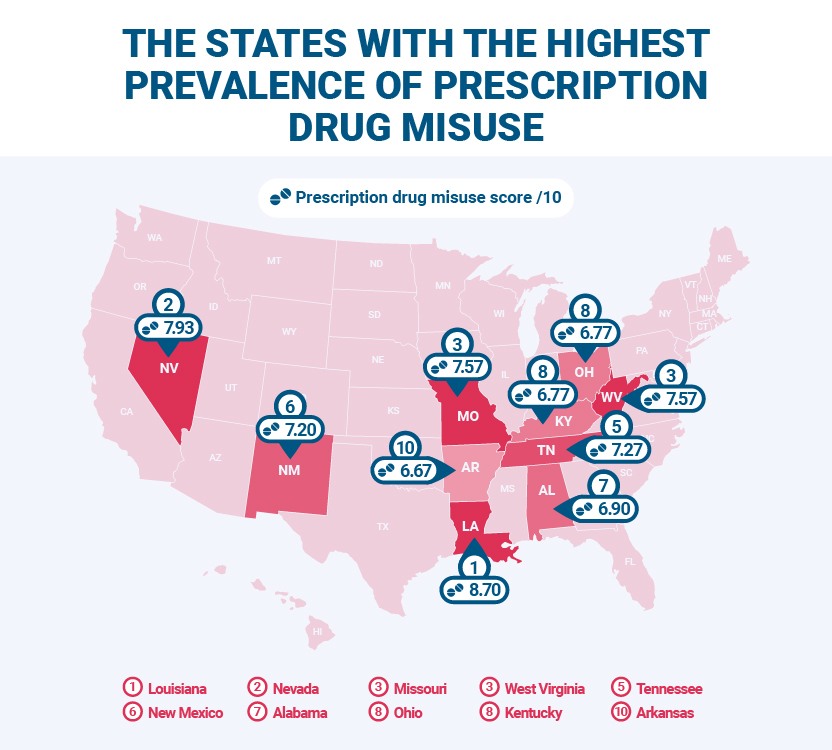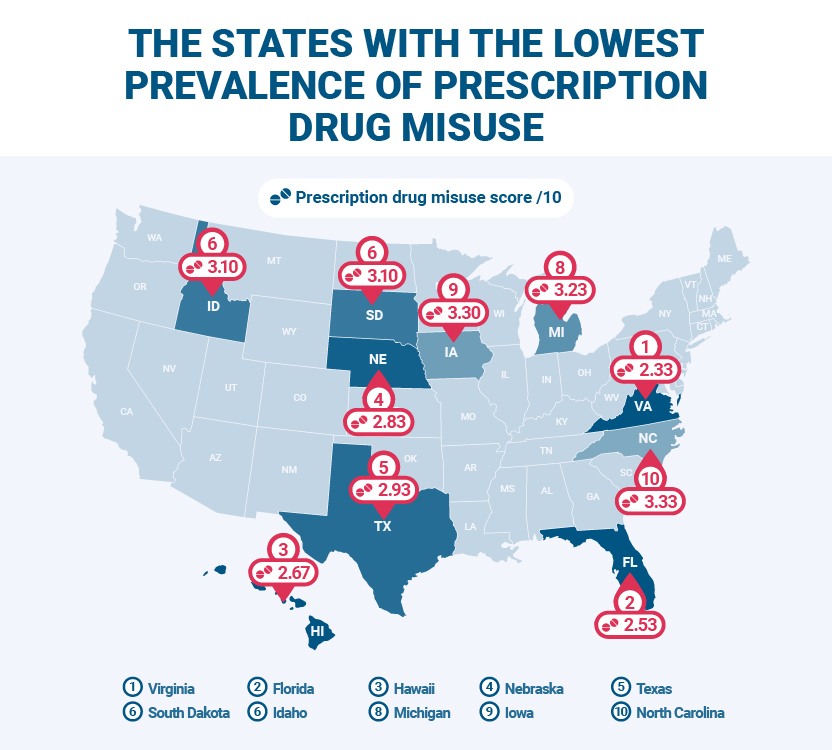Which US states have the highest prevalence of prescription drug misuse?
Prescription drug misuse is a big problem in the US. It’s estimated that 52 million (18.4%) of the population over the age of 12 have misused prescription drugs at least once in their lifetime.
But which states have the biggest problem with prescription drug abuse? The team at Universal Drugstore has dove into the data to find out. We’ll be looking at overdose mortality rates and proportions of people misusing prescription drugs and needing substance use treatment. We’ve also looked at the states with the most severe penalties for prescription drug possession.
The states with the highest prevalence of prescription drug misuse


-
Louisiana
Prescription drug misuse score: 8.70/10Louisiana takes the unfortunate title as the state with the highest prevalence of prescription drug abuse. The state ranks in the top five for two-thirds of the factors we looked at. It scores particularly high for people misusing opioids at 3,575 per 100,000 people. It also ranks third for its proportion of people misusing prescription pain relievers at 3,357 per 100,000 people.
-
Nevada
Prescription drug misuse score: 7.93/10Despite having a relatively low overdose mortality rate, Nevada takes second place with a score of 7.93. The state has the highest rates of prescription pain reliever and methamphetamine misuse at 3,556 and 1,888 per 100,000 people, respectively.
-
Missouri
Prescription drug misuse score: 7.57/10Sharing third place is Missouri, with a score of 7.57 out of 10. Despite ranking near the middle of the pack for its drug overdose mortality rate, the state places in the top ten for its proportion of people misusing prescription pain relievers at 3,124 per 100,000. It also shares fifth place for its Schedule II drug possession fines, a maximum of $10,000.
-
West Virginia
Prescription drug misuse score: 7.57/10Also in third place is West Virginia. The state ranks in the top five for its maximum fine for Schedule II drug possession, which includes prescription medications, at $10,000. It also ranks in the top 10 for the proportion of people misusing prescription pain relievers, at 3,124 per 100,000. Overall, it scores 7.57 out of 10.
The states with the lowest prevalence of prescription drug misuse


-
Virginia
Prescription drug misuse score: 2.33/10Virginia tops the list as the state with the lowest prevalence of prescription drug use, scoring 2.33. The state has the third-lowest proportion of methamphetamine use at 346 per 100,000 people. It also ranks just outside the top five for its low proportion of people misusing opioids at 2,350 per 100,000.
-
Florida
Prescription drug misuse score: 2.53/10Florida takes second place. The state has the lowest rate of people misusing opioids at 2,284 per 100,000 people. Florida also has the third lowest rate of people needing substance use treatment, at 14,524 per 100,000 people. Overall, the Sunshine State scores 2.53 out of 10.
-
Hawaii
Prescription drug misuse score: 2.67/10Hawaii is up next with a score of 2.67 out of 10. The state ranks in the top five for both its low drug overdose mortality rate and people needing substance use treatment at 18.6 and 14,659 per 100,000 people, respectively. Hawaii also has the second-lowest rate of people misusing opioids at 2,293 per 100,000.
The states with…
The highest drug overdose mortality rate - West Virginia (80.9 per 100,000 people)


West Virginia has the highest rate of drug overdose mortalities in the country, at 80.9 per 100,000 people. To combat this, the West Virginia Department of Human Services has recently ramped up its distribution of naloxone kits to prevent opioid overdose deaths and expanded drug treatment programs.
The highest proportion of prescription pain reliever misuse - Nevada (3,556 per 100,000 people)


As well as relaxing the body and relieving pain, when taken as instructed by a healthcare professional, prescription strength pain relievers can create a sense of intense happiness or euphoria for users. This creates the potential for them to be misused recreationally. Nevada has the highest proportion of people misusing prescription pain-relieving medications, with 3,556 per 100,000 of the population.
The highest proportion of opioid misuse - Alabama (3,666 per 100,000 people)


Alabama has the highest rate of people misusing opioids on the list at 3,666 per 100,000. To combat the high rate of opioid misuse, the state has lessened restrictions on administering medications to people with opioid use disorders. These medications help opioid users detox from stronger substances like fentanyl.
The highest proportion of methamphetamine use - Nevada (1,888 per 100,000 people)


When it comes to methamphetamine use, Nevada takes the top spot with 1,888 users per 100,00 people. While methamphetamine is available as a prescription drug to treat ADHD, its misuse as a recreational drug has powerful stimulant effects. Long-time misuse of methamphetamine can lead to insomnia, increased aggression, and paranoia.
The highest proportion of people needing substance use treatment - D.C. (24,741 per 100,000 people)


With a rate of 24,741 per 100,000 people, D.C. has the highest proportion of people needing substance use treatment. This could be due to the low number of treatment centers in the district. However, this could change as D.C. recently opened its first 24-hour drug and alcohol treatment center in January 2024.
The highest fine for Schedule II drug possession - Georgia ($100,000)


Georgia has the harshest penalty for Schedule II drug possession in the United States, with a maximum fine of $100,000. Possession of prescription drugs illegally can also lead to a maximum sentence of eight years if users are caught with between one and four grams.
Dr Jamie Winn, PharmD at Universal Drugstore, comments on the misconceptions surrounding prescription drug misuse:
"With 52 million Americans expected to have battled prescription drug misuse, it’s clear that this is a huge issue that is not easily understood. While some people seek out these drugs illegally, many people take medications that are prescribed to them in a way that isn’t intended by their doctor, with the intention of getting high.
“While warning signs can vary from person to person, people misusing prescription drugs can include a loss of inhibitions. This can lead to risky behaviors and avoidance of everyday responsibilities. Signs of prescription drug misuse can also include sudden mood swings, anxiety, depression, or irritability, so watch out for these behaviors if you think a loved one or someone you know may be misusing prescription drugs. Repeated misuse of prescription medications can lead to dependence on these substances.
“As prescription drug misuse has serious consequences, it's important to obtain your medications from a trusted provider. This gives you the peace of mind that your prescription will be the appropriate treatment for your condition. It also ensures that your medication will be safe and effective, and if you experience any side effects, you can consult your provider to adjust your prescription.”
It’s legal to misuse prescription drugs
Many people think that if a doctor has prescribed a medication, it must be legal for anyone to use. This is untrue. If you’re caught using controlled substances without a valid prescription, you could be arrested, fined, or even face jail time. This also applies to sharing prescriptions with others, even if you have the same condition.
Prescription drugs are safer than illegal ones
One of the most common misconceptions is that if a doctor prescribes a medication, it’s fundamentally safe to use. However, just because it’s medicine, doesn’t mean it can’t be damaging to your health. Many prescription drugs are only safe if you follow medical advice. Going against the directions, like taking higher doses or using someone else’s prescription, could lead to a substance use disorder, overdose, or other complications.
Prescription drugs aren’t addictive
Many people believe that doctors won’t give you medications that could potentially cause a substance use disorder. This isn’t always the case. Doctors can prescribe addictive drugs if they are effective in treating conditions, like mental health conditions and relieving pain. Prescription medications that contain benzodiazepines or opiates are especially dangerous due to their addictive nature.
If you suspect a friend or family member is ignoring the directions on their prescription medication, look out for physical symptoms like tremors, drowsiness, or slurred speech. This could indicate potential misuse.
Methodology
Beginning with a list of all 50 US states and Washington D.C., we analyzed each one on the following factors. We then gave each state a normalized score out of ten for each of the factors before taking an average across each of these scores to reach our final overall score out of ten.
Drug overdose mortality rate by state
The total number of drug overdose mortalities in each state in 2022 per 100,000 of the total population, according to the Centers for Disease Control.
Prescription pain reliever misuse by state
The average annual estimated number of people misusing prescription pain relievers in each state in 2021 and 2022 per 100,000 people, according to the Substance Abuse and Mental Health Services Administration.
Opioid misuse by state
The average annual estimated number of people misusing opioids in each state in 2021 and 2022 per 100,000 people, according to the Substance Abuse and Mental Health Services Administration.
Methamphetamine use by state
The average annual estimated number of people misusing methamphetamine in each state in 2021 and 2022 per 100,000 people, according to the Substance Abuse and Mental Health Services Administration.
People needing substance use treatment by state
The average annual estimated number of people needing substance use treatment in each state in 2021 and 2022 per 100,000 people, according to the Substance Abuse and Mental Health Services Administration.
Prescription drug abuse laws
The maximum fine for Schedule II drug possession in each state, according to Justia, except for North Carolina, for which data was unavailable.
Population figures for each state in 2023 were sourced from The United States Census Bureau.







